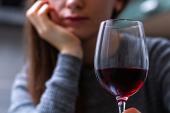Even a Single Drink per Day Increases Blood Pressure
There is no lower threshold in which alcohol didn’t increase both systolic and diastolic blood pressures, a new study shows.

Drinking even small amounts of alcohol—as little as one drink a day—increases both systolic and diastolic blood pressure, according to the results of a new meta-analysis.
The increase in systolic blood pressure with a single drink was small, around 1.25 mm Hg, but researchers say the new findings show there is no threshold at which alcohol is safe when it comes to changes in blood pressure.
“We saw more or less a linear, direct relationship between alcohol intake and blood pressure,” said Paul Whelton, MD (Tulane University School of Public Health and Tropical Medicine, New Orleans, LA). “With systolic blood pressure, which is really what is important, especially in adults, it was very linear and very robust. We saw it in men, in women, in North Americans, and in Asians. There were a couple of blips for diastolic blood pressure.”
Whelton, one of the study investigators and chair of writing committee that drafted the US hypertension guidelines, said there is a wealth of data linking alcohol to changes in blood pressure. Intervention trials, however, have largely been conducted in adults with higher alcohol intakes and have been relatively short duration. “There’s limited data getting at the vexing question of what about relatively small intakes of alcohol,” he told TCTMD. “Typically, we haven’t been able to answer the question. We’ve said there might be a relationship there, but we haven’t had the statistical power in the studies that have been done.”
To address the question, the researchers, led by Silvia Di Federico, MD (University of Modena and Reggio Emilia, Italy), performed a dose-response meta-analysis of nonexperimental cohort studies. The meta-analysis, which was published this week in Hypertension, included seven cohort or case-cohort studies of 19,548 healthy adults looking at the relationship between alcohol and changes in BP during extended follow-up. The studies, conducted either in North America or Asia, were published between 1997 and 2021. The median follow-up was 5.3 years, with a range of 4 to 12 years.
If you have high blood pressure or are in a group at risk for high blood pressure, you should be particularly wary about alcohol intake. Paul Whelton
Overall, there was an “almost linear” positive association between baseline alcohol consumption and BP changes over time. Systolic and diastolic BP were 1.25 and 1.14 mm Hg higher with each 12 g/day drink of alcohol compared with no alcohol consumption. Doubling the amount of daily alcohol consumption (24 g/day), which is slightly less than the amount of alcohol in two standard drinks, was associated with increases in systolic and diastolic BP of 2.48 and 2.03 mm Hg, respectively. At 48 g/day, systolic and diastolic BP were 4.90 and 3.10 mm Hg higher, respectively.
In an analysis stratified by sex, which included 12,196 men and 5,632 women, the association between alcohol consumption and BP was almost linear in both, although the curve was steeper in men than women. For men, alcohol intakes of 12 g/day or 48 g/day increased systolic BP 1.33 and 4.95 mm Hg, respectively, when compared with no alcohol consumption. In women, the respective increases in systolic BP were 0.82 and 3.31 mm Hg, respectively.
In women, diastolic BP was not directly associated with alcohol consumption, with investigators reporting the relationship appeared to be U-shaped. For example, in men, higher alcohol intakes were associated with increases in diastolic BP, but there was a 1.27-mm Hg reduction in diastolic BP for women consuming 48 g/day of alcohol.
Among Asian participants, there was a direct linear relationship between increasing alcohol consumption and rising diastolic BP, but the association in North American participants tended to flatten out in those who drank more than 24 g/day. For example, consuming 12 g/day or 48 g/day of alcohol increased systolic BP in North Americans by 1.50 and 5.25 mm Hg, respectively, while diastolic BP increased by just 0.97 and 0.96 mm Hg, respectively. In the Asian studies, systolic BP increased by 1.24 and 4.89 mm Hg with 12 or 48 g/day of alcohol while diastolic BP increased by 1.14 and 3.65 mm Hg.
Regarding the “couple of blips” observed in the association between alcohol and diastolic BP, Whelton said the finding is interesting from a research perspective, but that it’s not as critically important as the linear association seen with systolic BP given the latter’s connection with cardiovascular events.
Whelton noted that investigators chose 12 g of alcohol as that’s the standard amount per drink in Europe. In North America, one standard drink contains 14 grams of alcohol. He added that when drinks are poured liberally in restaurants or bars, there can be substantially more alcohol in a single serving. “It’s often not a standard drink,” he said. “Most people might think they’re having one drink per day, but it can be considerably larger than that.”
In terms of a clinical message, Whelton told TCTMD that individuals who aren’t drinking definitely shouldn’t start. The World Health Organization, in fact, stated earlier this year that no amount of alcohol is safe for human health. The American Heart Association dietary guidelines do not recommend alcohol to improve cardiovascular health, but say that if someone does drink, it’s one drink for women and one to two drinks for men, and no more per day.
Whelton said the story around alcohol has been complicated historically because observational studies have suggested there is a lower risk of coronary heart disease with modest drinking. That relationship between alcohol and coronary heart disease, said Whelton, could be the result of residual confounding or it might be that alcohol increases HDL cholesterol in a way that offsets the rise in blood pressure. Nonetheless, the data clearly show that even very small amounts of alcohol can alter cardiovascular risk factors.
“From a blood-pressure perspective, the data is very clear,” he said. “If you have high blood pressure or are in a group at risk for high blood pressure, you should be particularly wary about alcohol intake.”
Michael O’Riordan is the Managing Editor for TCTMD. He completed his undergraduate degrees at Queen’s University in Kingston, ON, and…
Read Full BioSources
Di Federico S, Filippini T, Whelton PK, et al. Alcohol intake and blood pressure levels: a dose-response meta-analysis of nonexperimental cohort studies. Hypertension. 2023;Epub ahead of print.
Disclosures
- The authors report no relevant conflicts of interest.





Comments